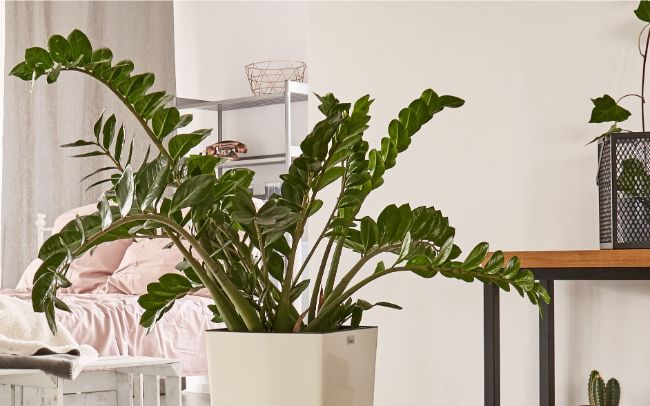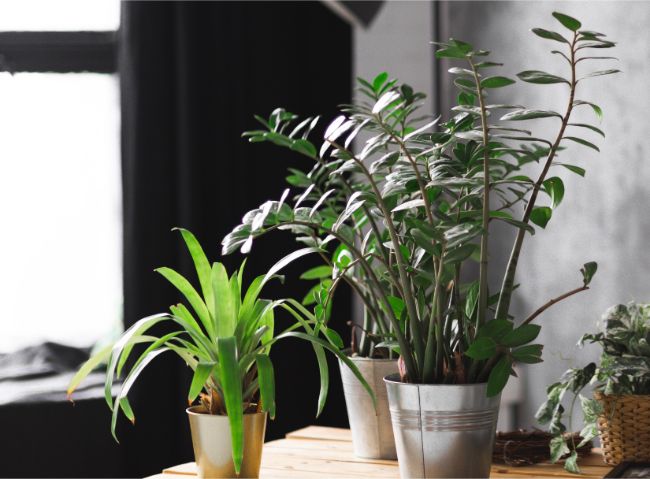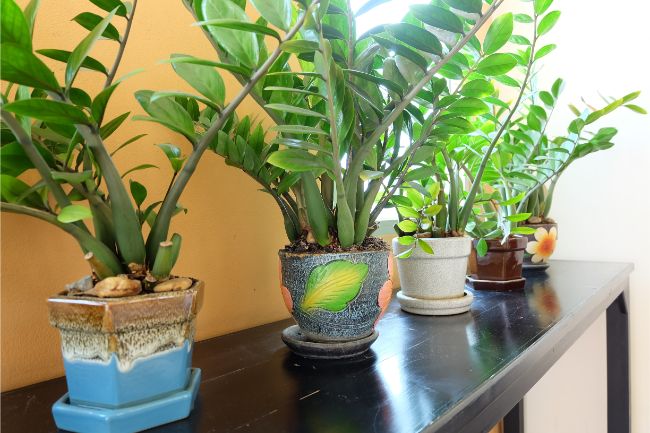Widely reputed to be easy to care for, and often said to thrive on neglect, ZZ plants (Zamioculcas zamiifolia) are a popular indoor plant. However, there are a few common problems such as zz plant stalks falling over, which can affect their health and aesthetics. This article is going to explain why ZZ plant stalks fall over or droop, and how to prevent and fix the problem for good.
Why are my ZZ plant stalks falling over? ZZ plant stalks most commonly droop or fall over due to overwatering, which leads to root rot. ZZ plant stems can also fall over due to light problems, severe under-watering, lack of or excessive fertilizer, cold stress, transplant stress or trauma.
The key to preventing and fixing a ZZ plant with stalks that are drooping is to correctly identify and treat the underlying problem. The good news is that there are solutions for most issues that could be plaguing your plant. Read on to learn exactly how to fix your ZZ plant.
Overwatering Is A Common Cause Of ZZ PLant Stalks Falling Over
The ZZ is a succulent native to Eastern Africa. Its history in semi-arid regions has made it adaptable to long periods of dryness and sporadic downpours. The rhizome root system of the ZZ allows it to hold on to water. However, it does need time to dry out between watering, as overly wet soil can cause the rhizomes to rot and decay.
If you see your ZZ plant stalks falling over, you must think of overwatering as the most likely cause and investigate. Overwatering causes persistently waterlogged soil that reduces aeration of the soil. This creates a root environment that is unable to absorb oxygen, creating unhealthy roots. Waterlogged soil is a perfect environment for a range of anaerobic bacteria and fungi to thrive, which can attack the roots, causing root rot.
When root rot strikes, the plant may look entirely healthy until the problem is quite severe. Once you notice yellowing of the leaves or ZZ plant stalks falling over and drooping, it may be too late.
- If you suspect root rot, you should remove your ZZ plant from it’s pot.
- Roots affected by root rot will be mushy and fragile and these should be removed with sterile pruning shears.
- Repot your ZZ plant into well draining soil and ensure the pot is not excessively large and has plenty of drainage holes.
- Once your plant has been successfully repotted, you should only water your ZZ plant once the potting mix is almost dry.
- Ensure that you empty any excessive water from the drip tray or decorative pot a few minutes after watering.

Underwatering Can Cause Drooping Too
Although less common, underwatering can also cause ZZ plant stalks to fall over, but for a completely different reason. If you just forget to water your ZZ plant, or are excessively cautious with watering, your plant will slowly dehydrate. Although they hold up remarkably well, eventually, the leaves will start to dry up, curl and drop, and the plant stems will droop and start to fall over.
Thankfully, there is an easy fix to this problem. Check the soil, and if it is completely dry and the leaves are crispy and curled, simply water your plant thoroughly, and the stalks will soon stand up tall again once the under-watering has been remedied.
When watering your ZZ plant, I normally suggest checking on your plant once per week. Feel the soil, look at the leaves and feel the weight of the pot. These will all help you know if it is time to water your plant. I’ve covered exactly how to water your ZZ plant in this article, if you want to learn more.
Once your plant needs watered, don’t just give it a little trickle of water. Thoroughly soak the soil until water runs freely out the drainage holes. I normally take my plants to the sink to water them, ensuring the soil gets a good soaking, and then wait until excess water has drained from the pot, before replacing the plant back in it’s spot.
The frequency your plant needs watered will totally depend on the plant and your growing conditions. A ZZ plant may need watered once a week, or it may take as long as 4-5 weeks for the soil to dry out.
Be guided by your plant and the soil rather than any schedule you have read, and your ZZ plant will thank you for it and you won’t have to see your poor ZZ plant stalks drooping down to the floor.
Read more about how to assess the watering needs of your indoor plants in this article.
Lighting Problems Can Cause ZZ Plant Stalks To Droop
Your ZZ plant will be at its healthiest in bright to moderate indirect light, but they can tolerate a wide range of conditions without affecting their health too much.
They can generally handle a dull north facing room or bright light and some direct sunlight per day without suffering too much. However, at the extremes of lighting, your ZZ plant will start to show signs of trouble.
Excessive Light
In excessively bright conditions, you may notice that your plant’s stalks appear to be leaning away from sources of light or may be looking droopy. The leaves may also curl or yellow and could also start to fall off.
The best way to resolve an issue with lighting is to relocate the plant to a less sunshine-filled part of your home. If you can’t find another spot for the plant to grow, consider tempering the bright light with curtains or blinds.
Low Light
When exposed to very low light conditions, most ZZ plants grow much more slowly, but new growth will become stretched and arch away from the plant in search of light. This will produce stems that droop, spoiling the natural aesthetics of your ZZ plant.
Try moving your ZZ plant closer to a window or provide some supplemental lighting from fluorescent or LED grow lights, if your space has no access to natural light.

Fertilizer Problems Can Cause ZZ Plant Stalks To Fall Over
ZZ plants generally aren’t very picky about the type of fertilizer that they receive. While some ZZ plant growers maintain a belief that the plant doesn’t need to be fertilized, at all, most plants will benefit from soil additives at some point in order to promote healthy growth.
If you’ve eliminated all other potential reasons for the stalks drooping or falling over, you may find it simply needs a good boost of fertilizer to help encourage it to thrive.
You should fertilize your ZZ plant once every 3-6 months with a well-balanced water soluble fertilizer. This is the one I use. If your plant seems to be dropping leaves and drooping soon after fertilizing it, you may want to evaluate the type and amount of fertilizer that you are using.
Both over and under-fertilizing the plant can lead to a range of issues with it, resulting in the stalks falling over or yellowing.
Using fertilizer spikes typically isn’t advisable, as they can potentially be strong enough to burn the roots of your plant. If you have used fertilizer spikes or a too-strong liquid fertilizer, you may want to consider repotting the plant with fresh soil and holding off on fertilizing it for some time until it has had opportunity to recover.
Low Temperatures
The hardy ZZ plant generally thrives in temperatures that don’t dip below 65°F. Temperatures that drop below 45°F can lead to stunted growth, while exposure to freezing temperatures may result in the leaves wilting and falling off. The plant stalks may also fall over, turn brown, and ultimately break off. If your plant is suffering from cold stress or shock, it may not be too late to revive it and get those stalks back to standing tall.
Return the plant to a warm area of your home and cut back any of the damaged stalks. Keep the plant warm, with bright, indirect light and allow it to recover from the stress of being exposed to freezing temperatures.
Depending on the extent of the damage to the plant from the cold stress, it should start to stand up again and also show signs of new growth within a few weeks.
Transplant Stress
It’s just good plant care to periodically repot ZZ plants into larger containers. While most plants tolerate transplanting really well, even the hardiest of plants can begin to show a bit of stress after their roots have been disrupted. One of the first signs that a transplanted ZZ plant is struggling with transplant stress will be seeing the stalks slump over.
There are any number of reasons for ZZ plant stalks falling over after transplanting, with the primary concerns being related to a lack of water or some type of damage to the roots during the transplant.
Generally speaking, you should avoid transplanting during the warmer summer months as this can quickly lead to the roots drying out when they are exposed to the air.
A plant that is drooping and showing signs of stress from being transplanted should be given time to recover. The plant will focus on root growth versus providing energy for the stalks when it is under some type of stress. Once the roots have been able to recover, the plant should start to perk up well.
Physical Damage To The Plant
ZZ plant stalks falling over can also be a sign of trauma to your plant. Small children, pets or rough treatment of your plant can lead to damage to the stalks, causing them to break and fall over. Damaged stalks are very unlikely to recover and should be removed with sterile pruning shears.
Last Word
ZZ plant stalks falling over is a sign of a rather unhappy plant. This otherwise hardy houseplant is telling you that something is wrong. Think of overwatering first, before checking for any of the other problems. Best of luck in returning your ZZ plant to good health.

